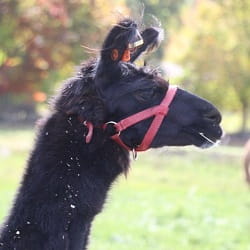Llama Nanobodies Most Potent Weapon To Fight COVID

Wally the llama, who lives in Massachusetts, has helped researchers at the University of Pittsburgh School of Medicine produce nanobodies, which, so far, is the most potent way to fight COVID-19. Submitted photo
Special llama antibodies called nanobodies is the most effective way to fight COVID-19, so far.
On Thursday, the University of Pittsburgh School of Medicine hosted an online news conference to discuss the research published in “Science” magazine that describes a new method to extract tiny, but extremely powerful SARS-CoV-2 antibody fragments from llamas, which could be fashioned into inhalable therapeutics with the potential to prevent and treat COVID-19. The nanobodies are much smaller than human antibodies and many times more effective at neutralizing the SARS-CoV-2 virus. They’re also much more stable.
“The most potent to date to fight the virus,” said Dr. Yi Shi, Pitt assistant professor of cell biology, about the potential of llama nanobodies. “Nature is our best inventor. The technology we developed surveys SARS-CoV-2 neutralizing nanobodies at an unprecedented scale, which allowed us to quickly discover thousands of nanobodies with unrivaled affinity and specificity.”
Shi has been working with Dr. Paul Duprex, Pitt center for vaccine research director, on testing the antibodies on animal models.
“The results in these models are really promising,” Duprex said.
Shi was asked about the possible timeline for nanobodies to be produced into a possible treatment against COVID-19.
“We’re trying the best we can to move forward to clinical trials,” Shi said.
Duprex added that the potential therapy has to go through three phases of trials and has to be proven to safely be delivered to potential patients before the treatment could be available to the public.
“And that takes time,” he said.
During the news conference, the doctors were asked about the llama used in the production of the nanobodies. Shi said the llama’s name is “Wally” and it lives in Massachusetts. He said the llama was named Wally because it resembles his black labrador that goes by the same name. The llama was not hurt in the production of the nanobodies.
“Currently he is our best friend. Hopefully he will help us fight through COVID-19,” Shi said. “Wally is perfectly fine.”
Shi and colleagues immunized the llama with a piece of the SARS-CoV-2 spike protein and, after about two months, the animal’s immune system produced mature nanobodies against the virus.
Using a mass spectrometry-based technique that Shi has been perfecting for the past three years, lead author Yufei Xiang, a research assistant in Shi’s lab, identified the nanobodies in Wally’s blood that bind to SARS-CoV-2 most strongly.
Then, with the help of Pitt’s Center for Vaccine Research, the scientists exposed their nanobodies to live SARS-CoV-2 virus and found that just a fraction of a nanogram could neutralize enough virus to spare a million cells from being infected.
These nanobodies represent some of the most effective therapeutic antibody candidates for SARS-CoV-2, hundreds to thousands of times more effective than other llama nanobodies discovered through the same phage display methods used for decades to fish for human monoclonal antibodies.
Shi’s nanobodies can sit at room temperature for six weeks and tolerate being fashioned into an inhalable mist to deliver antiviral therapy directly into the lungs where they’re most needed. Since SARS-CoV-2 is a respiratory virus, the nanobodies could find and latch onto it in the respiratory system, before it even has a chance to do damage.
In contrast, traditional SARS-CoV-2 antibodies require an IV, which dilutes the product throughout the body, necessitating a much larger dose and costing patients and insurers around $100,000 per treatment course.
“Nanobodies could potentially cost much less,” said Shi. “They’re ideal for addressing the urgency and magnitude of the current crisis.”
In collaboration with Dr. Cheng Zhang at Pitt, and Dr. Dina Schneidman-Duhovny, at the Hebrew University of Jerusalem, the team found that their nanobodies use a variety of mechanisms to block SARS-CoV-2 infection. This makes nanobodies ripe for bioengineering. For instance, nanobodies that bind to different regions on the SARS-CoV-2 virus can be linked together, like a Swiss army knife, in case one part of the virus mutates and becomes drug-resistant.
“As a virologist, it’s incredible to see how harnessing the quirkiness of llama antibody generation can be translated into the creation of a potent nanoweapon against clinical isolates of SARS-CoV-2,” Duprex said.
Additional authors on the study include Dr. Sham Nambulli, Zhengyun Xiao, Dr. Heng Liu, and Zhe Sang, all of Pitt.
Funding for this study was provided by the National Institutes of Health, the University of Pittsburgh Clinical and Translational Science Institute, Pitt Center for Vaccine Research and the DSF Charitable Foundation.



